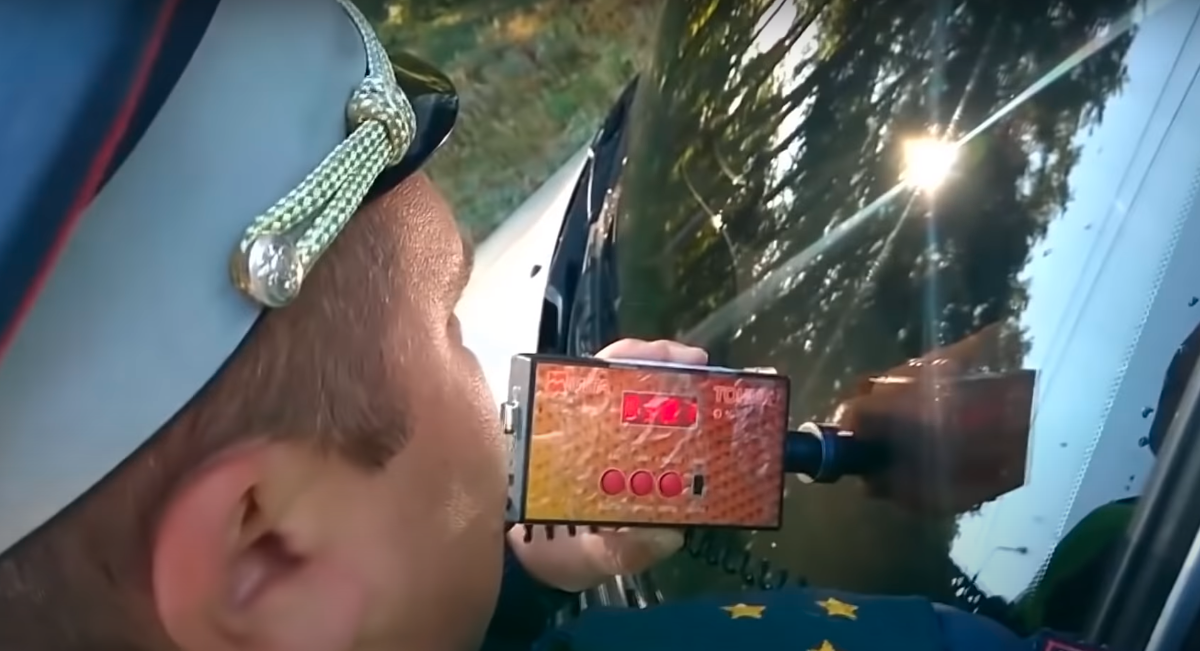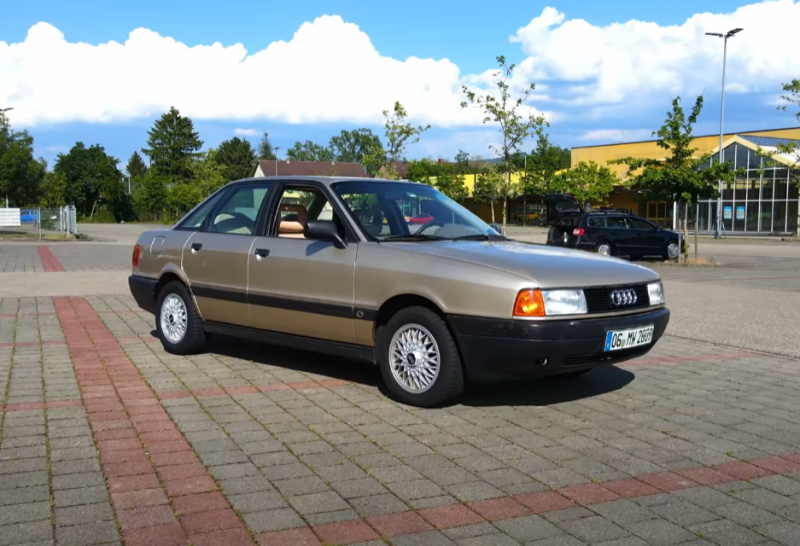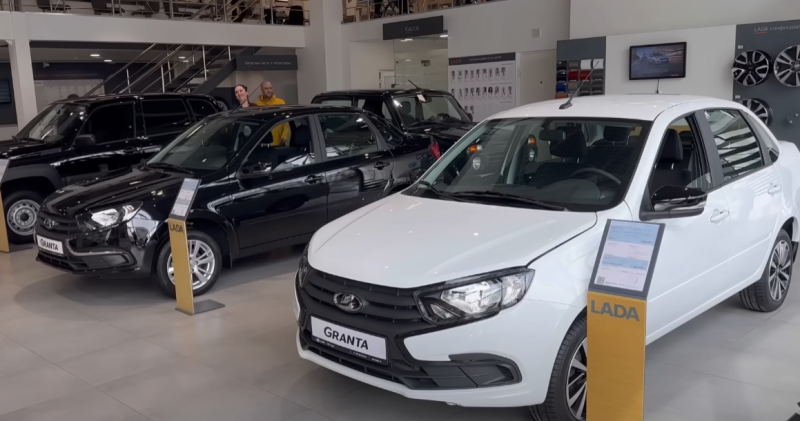Today, there are several ways to tint that bypass traffic rules. Between themselves, they differ in technology of use and cost.
Double glazing
The simplest method, the essence of which is clear from the name. To achieve the desired effect, a pair of glasses is immediately inserted into the door. One of them has a normal light transmission capacity, determined by the traffic rules, the other is tinted.
 By pressing the button, you can raise a simple or tinted glass. Photo: Youtube.com
By pressing the button, you can raise a simple or tinted glass. Photo: Youtube.comUnder the door card will have to be finalized:
✅ install “own” guides for the second glass
✅ connect a separate electric motor
✅ put "your" button-key
The outer glass must be transparent, the inner glass must be tinted (it is possible and vice versa, but it is undesirable - the traffic police inspector sees the window from the outside). Its light transmission capacity depends on the type of the pasted film. The cost of such a service for two front windows is within 30 thousand rubles.
SPD technology
Its homeland is the USA and it implies the application of the thinnest film on glass, which includes rod-shaped microparticles. Each of them is a clot of special water that does not conduct electricity. When the latter does not affect the microparticles, they are arranged in a chaotic manner, forming a dense opaque layer. When a voltage is applied to the film, they level out and "scatter" away from each other. The greater the distance between the particles (current strength), the lighter the film becomes.
 On the rear window, the usual tinting, on the front - electronic (begins to act). Photo: Youtube.com
On the rear window, the usual tinting, on the front - electronic (begins to act). Photo: Youtube.comIn this case, the level of darkness can vary in the range from 10 to 90 percent. The technology implies the possibility of using specially prepared glass instead of a film: for example, Vario Plus.
The invention is patented by Research Frontier. However, the rights to use it were purchased by AGP, which produces products called Cromolite.
In Russia, this is not produced. If you decide to order such tinting, you must tell the seller the VIN code of the factory glass installed on your car. This is necessary to determine the dimensions of the product. The delivery set should include a controller with which the light transmission of the glass is adjusted. It connects to the car's on-board computer. The entire system will cost at least 395 thousand rubles. for a set of a pair of side windows.
How to care for SPD glass
For washing, use only a soft sponge, which is not based on microfiber. Detergents, as well as water temperature, can be any. It is undesirable to keep the glasses wet for a long time. After washing, wipe them with a clean, dry cloth or tissue (you can use toilet paper). Also pay attention to the insulation of the contacts (junctions) connected to the glass and connecting it to the controller. Wires should lie on a flat surface, with a minimum of bends.
 It is better to wash windows, including tinted ones, with special products. Photo: Youtube.com
It is better to wash windows, including tinted ones, with special products. Photo: Youtube.comGlass made using SPD technology has a service life of 10 years. The film will last less than twice.
PDLC technology
This is a monochrome tinting, performed using a pair of special films, between which there is a layer of liquid crystals. In the absence of voltage, they move randomly and do not react with polymers, due to which the window surface reflects the sun's rays well. When electricity is applied to the glass, a force field is formed between the films, forcing the crystals to move in the "needed" direction, connecting with each other. As a result, the window "brightens".
 Electrically tinted front windows using the PDLC method. Photo: Youtube.com
Electrically tinted front windows using the PDLC method. Photo: Youtube.comThe author of this technology is the South Korean company DM DISPLAY. Its engineers in the manufacture of films that change light transmission, managed to use relatively inexpensive components. Therefore, the cost of such tinting is 7-8 times lower than the American one, which contributes to the popularization of services using PDLC technology.
The South Korean company produces two types of films: conventional, Smart type and adhesive-based - Smart Glass. Triplex is made from the latter in Russia, ready for installation. To activate the film, you need to apply 100-110 volts of alternating voltage to it through copper contacts glued with silver paste.
Despite its uniqueness, this technology has not found wide application in the automotive industry. This is due to its main drawback: in the absence of voltage on the contacts, the film becomes opaque on both sides, that is, it turns into a kind of "curtain". As a result, those sitting inside the car do not know what is happening outside, and those “overboard” will not see what is happening in the cabin. But what is not very suitable for a car is in demand in other areas. For example, the film is useful for arranging office partitions, cottages, cottages, and shops. In the latter case, a unique quality of the material is used - the rear projection.
 Use of rear projection for promotional purposes. Photo: Youtube.com
Use of rear projection for promotional purposes. Photo: Youtube.comIf such a film is placed in a shop window, then through a film projector it is possible to broadcast an image that passers-by will see outside the outlet. That is, this is an excellent advertising option.
How to make electric tinting cheaper
It would be strange if the Chinese passed by such an invention and did not try to make it as cheap as possible. Today, on Ali Express, you can find "smart film" under various names (for example, Filmbase Store). The specifications indicate that this is a self-adhesive material made using PDLC technology (in the absence of tension, the surface will be opaque on both sides). Scope of use (according to instructions):
✅ office buildings
✅ residential buildings
✅ banks (for some reason)
✅ cars
A piece of canvas measuring one meter per meter costs 8860 rubles. (you can order according to your dimensions). But there is a “nuisance”: the film operates from an alternating voltage source with a frequency of 50 Hz at 60 volts. However, this is unlikely to be an obstacle for Russian masters. In addition, in most cases, an adapter is included in the kit sold (alas, most often under 220 V).
How to apply electronic tint film
Car glass, which will be Smart Film, must be thoroughly washed and dried. To do this, use special tools, napkins. You will also need a ruler, spatula. Course of action:
✅ measure the glass and make a pattern out of hard paper
✅ cut a film of the desired size on it with a margin of 1 cm
✅ remove the protective layer from the purchased material
✅ apply PDLC to the inner surface of the window, spread it with a spatula (napkin), slowly moving from the middle to the edges
✅ cut off excess
Insulate the contacts and place them under the door or passenger compartment trim (if the glass is rear). At the last step, connect the wires to the converter or the finished controller, depending on what you bought.
Features
A film or glass made using PDLC or American SPD technologies in a transparent state consumes energy of 6-7 W per 1 sq. m of toned surface. Not much, but you need to remember this when leaving the car for a long time without use.










